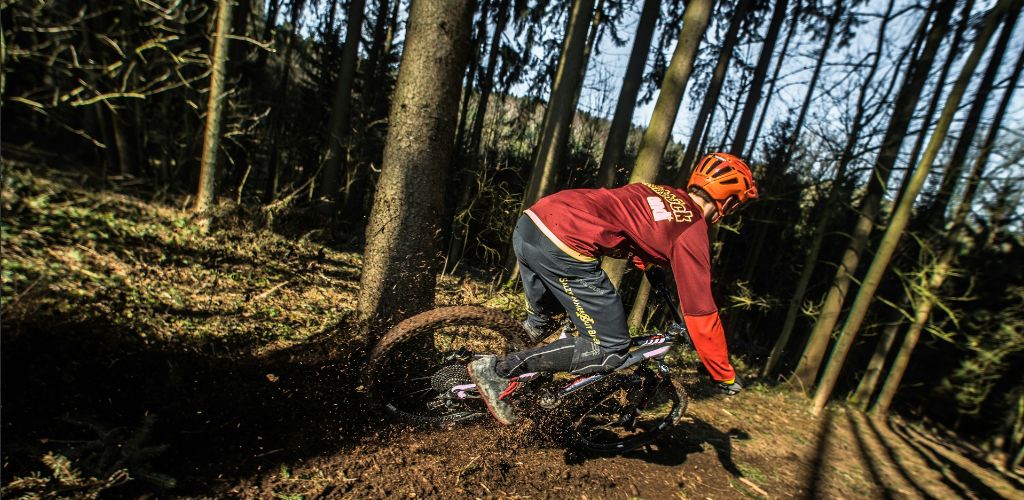Today we’re going to take a little look through the history and culture of mountain biking to see what fun facts about our beloved sport you need to know!
Let’s get started 🙂
Here’s a collection of facts about mountain biking:
- Origins and Evolution: Mountain biking originated in the 1970s in Marin County, California. It began with cycling enthusiasts modifying bikes for off-road trails, marking the birth of the sport. Joe Breeze is often credited with creating the first purpose-built mountain bike in 1978.
- Disciplines: Mountain biking includes various disciplines such as cross-country, downhill, enduro, and freeride. Cross-country and trail riding are the most popular, with 92.9% of mountain bikers participating in these styles.
- Olympic Sport: Mountain biking was included in the Olympics in 1996, bringing it global recognition and appeal.
- Health Benefits: Mountain biking is known for improving cardiovascular fitness and mental well-being. It requires the use of cardiovascular joints and releases endorphins, contributing to a good mood and enhanced bodily balance.
- Incredible Feats: Cam Zink holds the record for the longest dirt-to-dirt mountain bike jump, measured at 36.49 meters (119.7 ft) in 2014. Additionally, the most vertical descent on a mountain bike in 24 hours is 40,840 feet.
- Cultural Impact: The sport has a rich culture, influencing society in areas like art, music, fashion, and technology. It has inspired the development of specialized bikes and gear.
- Economic Growth: The global mountain bike market was valued at $16.4 billion in 2019, with a projected growth rate of 5% from 2020 to 2026.
- Trail Diversity: Mountain biking offers the chance to explore various trails worldwide, such as the Whistler Bike Park in Canada, known for its diverse trails and stunning scenery.
- Equipment Evolution: Early mountain bikes were modified road bicycles with wider frames and different handlebars. Today, mountain bikes come with advanced features like suspension systems and specialized tires for different terrains.
- Endurance Challenges: Ultra-endurance mountain bike races can cover distances of 100 miles (~160KMs) or more, and there are events like 24-hour competitions where riders aim to cover the most distance in a given time.
- Technological Innovations: Suspension systems in mountain bikes have seen significant advancements. Some models now feature up to 250mm of suspension travel, comparable to motocross motorcycles.
- Economic Demographics: In the United States, over half of the mountain biking community comes from households earning over $75,000 annually, indicating its popularity among the middle class and above.
- Wheel Size Evolution: The common wheel size for modern mountain bikes is around 29 inches, a considerable increase from the older 26-inch standard, enhancing the bike’s ability to traverse rough terrain.
- Record-breaking Descent: The world’s longest downhill mountain bike descent is a three-day trip in Nepal, starting at an elevation of 17,700 feet and descending through some of the world’s most extreme terrain.
- Pioneers of Mountain Biking: Key figures in the development of mountain biking include Joe Breeze, Tom Ritchey, Gary Fisher, Charlie Kelly, and Keith Bontrager, who contributed to the sport’s early designs and concepts.
- First Mountain Bike Magazine: The first magazine solely dedicated to mountain biking, “Mountain Bike Action,” was launched in 1985, signaling the sport’s growing popularity and influence.
- Safety Statistics: The mortality risk in mountain biking is comparable to that of mountain hiking, estimated at 0.02 per 1000 persons participating annually.
- Industry Growth: The global mountain bike market is projected to exceed $10 billion USD by 2026, reflecting the sport’s increasing popularity and the growing demand for specialized equipment.
- Trail Maintenance and Advocacy: Organizations like the International Mountain Bicycling Association (IMBA) play a crucial role in developing, maintaining, and advocating for mountain bike trails globally.
- Professional Earnings: The highest-paid mountain biker, Aaron Gwin, reportedly earned around $1 million USD, a significant increase from the earnings in the early days of professional mountain biking
Hope you found that interesting! See you on the trail 🙂


